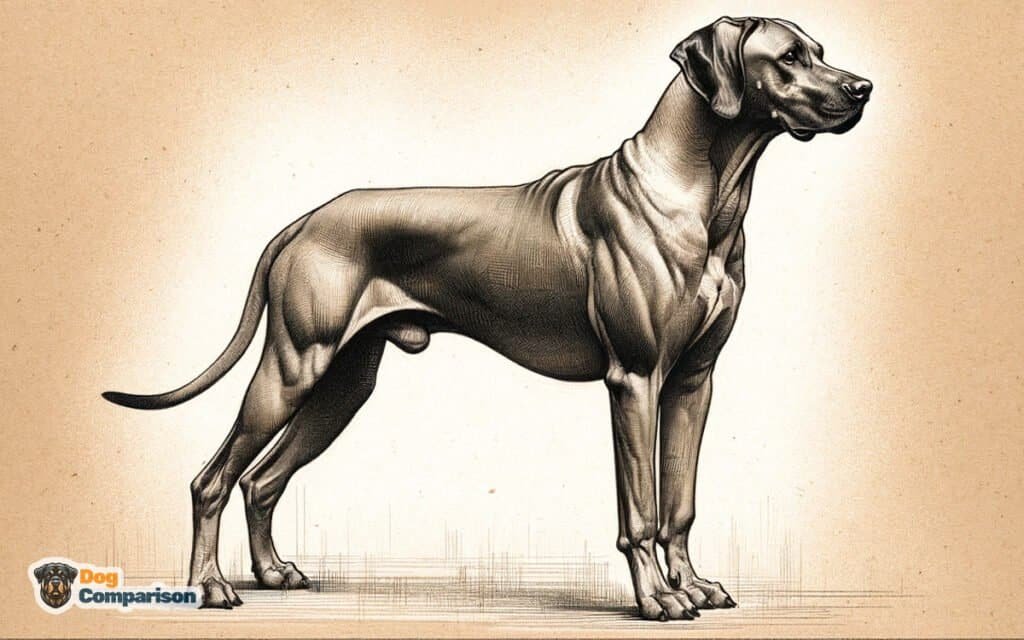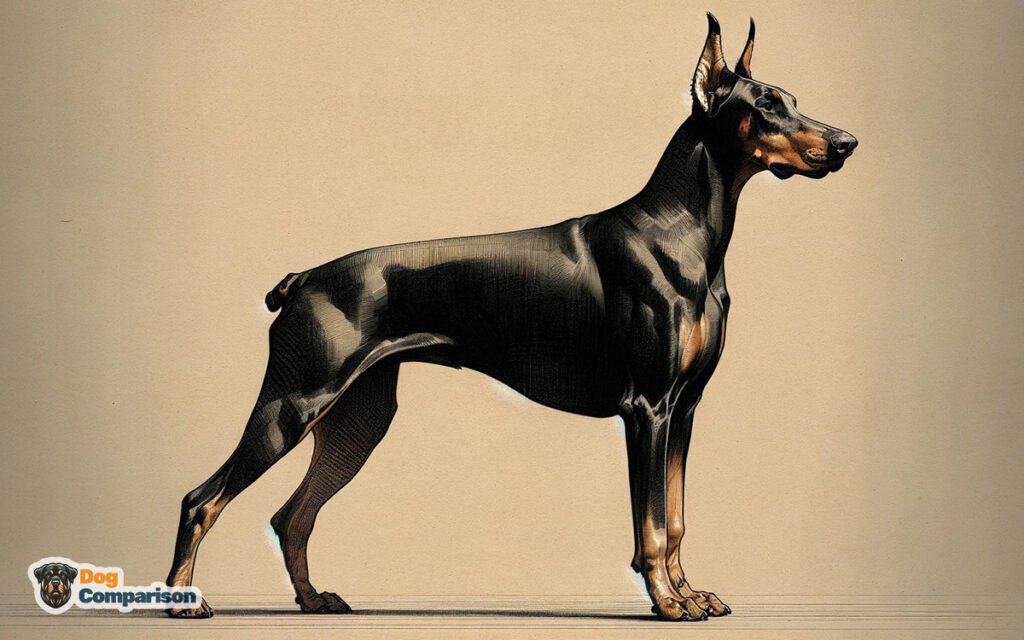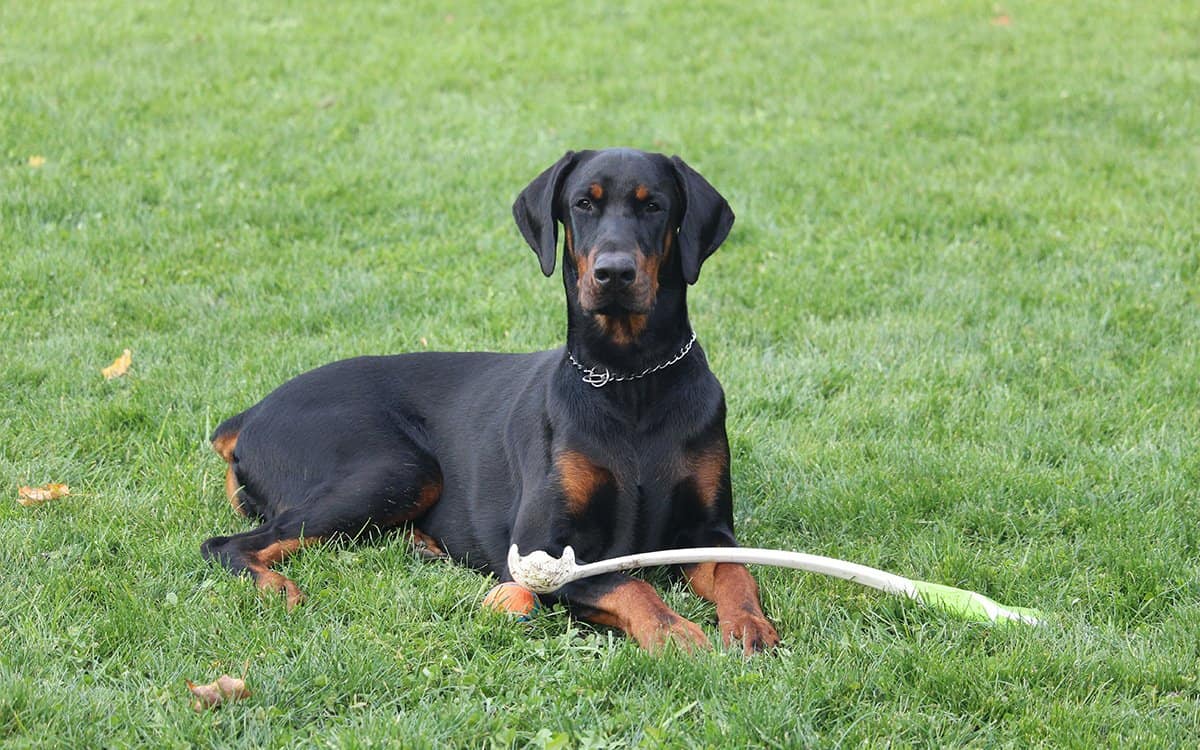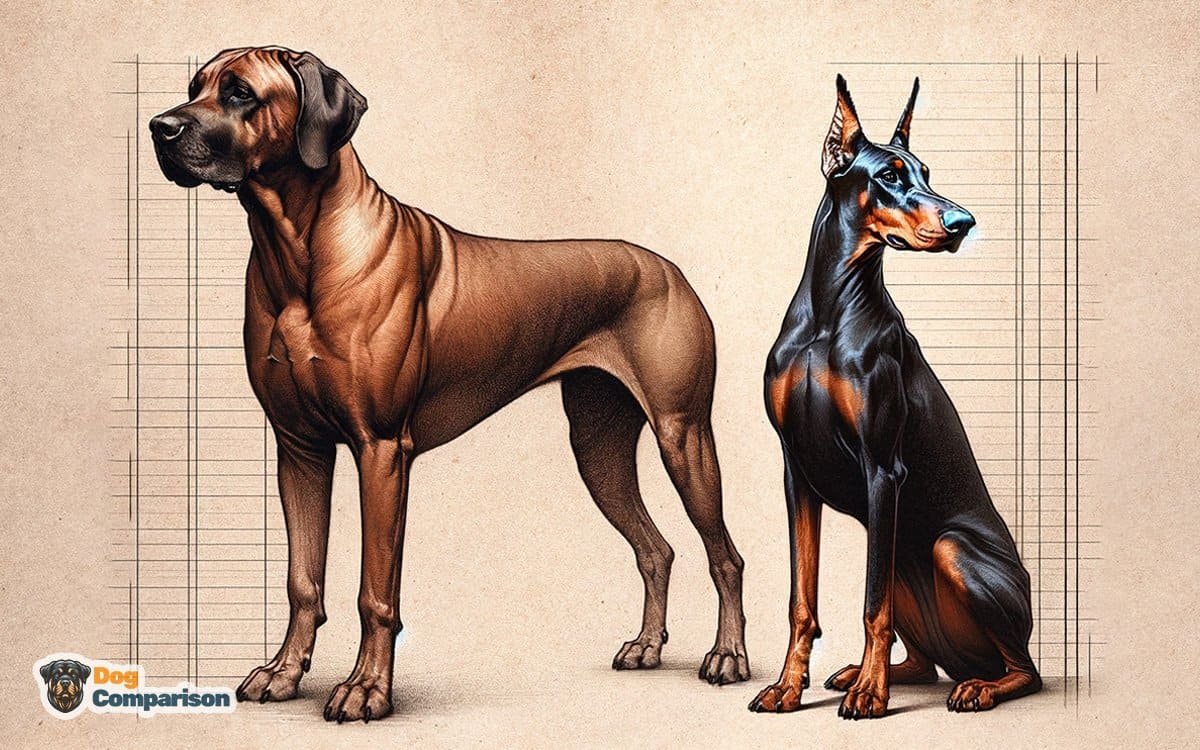Dobermans, on the other hand, were bred in Germany as guard dogs. They are highly energetic and require a lot of exercise. Dobermans are extremely loyal to their families and make excellent watchdogs due to their alert nature.
Both breeds need firm training from an early age but respond well once trained. However, because of their strong personalities, they might not be suitable for novice owners who haven’t had experience with large dogs before.
Table of Contents
Visual Differences – Rhodesian Ridgeback vs Doberman
The Rhodesian Ridgeback and the Doberman are both majestic dogs, but their appearances have some notable differences.
One of the most striking features of a Rhodesian Ridgeback is its unique ridge along its back. This ridge runs opposite to the rest of their coat and starts from just behind their shoulders to their hip area. It’s like having a natural mohawk!
On the other hand, Dobermans boast a sleek silhouette that emphasizes their muscular build. Their coat is smooth and lies flat against their body, giving them an elegant look.
Another point of distinction lies in their ears and tails. The ears of a Rhodesian Ridgeback remain natural throughout their life—they’re medium-sized and droop down close to the head.
Dobermans often have traditionally cropped ears which make them stand erect; this was originally done for functional reasons related to work or show standards but has become more about aesthetics today.
A Quick Overview – Rhodesian Ridgeback vs Doberman
Rhodesian Ridgeback | Doberman |
Height Males: 25-27 inches; Females: 24-26 inches | Height Males: 26-28 inches; Females: 24-26 inches |
Weight Males: 85 lbs; Females: 70 lbs | Weight Males: 75-100 lbs; Females: 60-90 lbs |
Coat Short, dense, sleek | Coat Short, hard, and thick |
Temperament Loyal, Intelligent, Dignified | Temperament Energetic, Watchful, Loyal |
Trainability Moderately Easy | Trainability High |
Lifespan 10-12 years | Lifespan 10-13 years |
Health Concerns Hip dysplasia, Dermoid sinus | Health Concerns Cardiomyopathy, Hip dysplasia, Wobbler syndrome |
Family-friendly Yes, with proper socialization | Family-friendly Yes, especially if socialized early |
Exercise Needs High | Exercise Needs |
Breed History of Rhodesian Ridgeback & Doberman


The Rhodesian Ridgeback traces its roots back to Southern Africa. They were developed for hunting, specifically to track lions.
This required a dog with not only strength but also intelligence and agility. The unique ridge on their back, from which they get their name, is a hallmark of the breed.
The Doberman Pinscher, commonly known as Doberman, has a different origin story. It was bred in Germany by Karl Friedrich Louis Dobermann in the late 19th century.
His goal was to create a protection dog that would be loyal and fearless. Thus, the Doberman’s history is deeply rooted in roles such as police and military work due to their alertness and loyalty.
Both breeds have evolved significantly from their original purposes but still carry traits that are reflective of their historical roles.
Rhodesian Ridgebacks maintain their hunter’s instinct, making them excellent guard dogs for homes.
On the other hand, Dobermans continue to excel in protective services due to their intelligence and bravery.
Appearance of Rhodesian Ridgeback & Doberman
Ridgebacks and Dobermans both have a strong presence but in different ways.

Ridgebacks show off their muscular, athletic build. They look ready to run fast or jump high at any moment.
On the other side, Dobermans are more streamlined. Their bodies are sleek and elegant.

Their faces tell stories too. A Ridgeback’s eyes are full of expression; they seem like they understand every word you say.
This breed’s gaze can be soft yet alert showing their friendly nature.
Doberman’s sharp gaze gives away their alertness right away. They always look like they’re on guard duty. This makes sense given their history as protection dogs.
Both breeds bring unique traits that make them stand out not just in looks but in personality too.
Coat & Colors
The Rhodesian Ridgeback and the Doberman have distinct coats that set them apart. The Ridgeback’s coat is short but dense, perfect for withstanding various weather conditions. On the other hand, Dobermans boast a smooth, fine texture that gives them a sleek appearance.
There’s a noticeable difference too. Ridgebacks are known for their Wheaton shades ranging from light to red wheaten. Dobermans offer more variety in this aspect. They come in black, red, blue, and fawn.
Both breeds have low shedding levels which is great news for owners concerned about hair around the house. However, their grooming needs aren’t identical due to their coat types.
The Ridgeback’s denser coat might catch more dirt and require regular brushing to stay clean and shiny. Despite its finer texture, the Doberman also benefits from routine care to maintain its glossy look.
Temperament
The Rhodesian Ridgeback and the Doberman are special dogs with their own ways.
Rhodesian Ridgebacks are independent and very loyal to their families, but they need patient training to listen well.
Dobermans are super alert and loyal too, making them great at watching over their homes and loved ones.
Both types of dogs really want to protect their families. But, it’s important for their owners to help them meet new people and experience different places when they’re young.
This helps prevent them from being scared or mean around strangers or in new situations.
Trainability
Both the Rhodesian Ridgeback and the Doberman possess high intelligence levels. This trait makes them capable of learning quickly. However, their intelligence comes with unique challenges during training.
The Rhodesian Ridgeback is known for its stubborn streak. Training this breed requires a lot of patience. You must be consistent and firm in your approach.
They need to understand who is in charge without feeling threatened or stressed. On the other hand, Dobermans often show an eagerness to please their owners. This characteristic can make them somewhat easier to train compared to Ridgebacks.
For successful training:
- Use positive reinforcement techniques.
- Be patient and consistent.
- Start socialization early.
Both dogs have a high energy level which means they require regular physical activity not just for health but also as part of effective training sessions that keep them mentally stimulated.
Exercise
Both Rhodesian Ridgebacks and Dobermans are high-energy breeds that need a lot of exercise. They can’t just sit around the house or office all day. If they don’t get enough exercise, they might start showing bad behaviors. This is because they get bored easily.
Rhodesian Ridgebacks were originally bred to hunt lions in Africa. This means they have a lot of endurance and love to run. A long run every day is good for them. It helps use up their energy and keeps them happy.
Dobermans, on the other hand, were bred to work and protect. They like having jobs to do. Agility training is great for them because it makes them think and move at the same time. It’s not just about being physically tired; their minds need to work too.
Remember, both breeds need mental stimulation as well as physical exercise every day. Without this, they might start doing things you don’t want them to do, like chewing or digging.
Making sure your dog gets enough exercise isn’t always easy but it’s worth it. They will be happier and so will you.
Grooming
Both Rhodesian Ridgebacks and Dobermans are loving members of the household that require minimal grooming. This makes them great companions for those who might not have a lot of time to dedicate to pet care. However, there are some grooming needs that cannot be overlooked.
Rhodesian Ridgebacks and Dobermans need their nails trimmed regularly. Long nails can cause discomfort or even lead to health issues. Similarly, keeping their ears clean is essential in preventing infections. These tasks are common to both breeds and important for their well-being.
The bathing schedules between these two breeds differ slightly due to their coat types. Rhodesian Ridgebacks have a short coat that requires less frequent baths, while Dobermans may need slightly more attention in this area due to their denser fur.
Brushing helps minimize shedding and keeps the coat healthy by distributing natural oils throughout the fur.
Feeding
Rhodesian Ridgebacks and Dobermans have different dietary needs. This is because of their size and energy levels. Rhodesian Ridgebacks are large dogs with high energy. They need food that supports this. Dobermans are also energetic but slightly smaller.
A high-quality diet is key for both breeds. It helps prevent health issues common in these dogs. Owners should choose foods rich in nutrients for muscle and bone health.
For puppies, feeding schedules are more frequent than adults. Puppies might eat three to four times a day. Adults usually eat twice daily.
- Rhodesian Ridgebacks often enjoy larger portions due to their size.
- Dobermans may require less food but need it to be nutrient-dense.
Both breeds benefit from diets low in fillers and high in protein. This matches their active nature.
Owners must watch the dog’s weight closely, adjusting the diet as needed.
Feeding these animals right keeps them healthy and happy family members.
Puppy Prices
The cost of a Rhodesian Ridgeback or Doberman puppy varies. It depends on several factors. Both breeds come from reputable breeders at different prices.
A Rhodesian Ridgeback puppy typically costs between $1,500 and $2,500. A Doberman’s price range is slightly lower, around $1,000 to $2,200. These prices can change based on the dog’s pedigree and the breeder’s location and reputation.
Buying a puppy is just the start. You also need to think about initial setup costs like beds, bowls, and toys. Ongoing care includes food, vet visits, and training. Remember how we talked about feeding? Quality food impacts your budget too.
Some people choose to adopt a rescue dog instead of buying a puppy. This can be less expensive upfront but still involves care costs over time.
Rhodesian Ridgeback Breeder List:
Doberman Pinscher Breeder List:
Health Conditions and Concerns
Both the Rhodesian Ridgeback and the Doberman face health problems due to their genetics. Hip dysplasia is a common issue in both breeds. It affects their hips, causing pain and mobility issues. Dobermans often suffer from heart conditions as well. These can be serious and need careful monitoring.
Ridgebacks have a unique concern called dermoid sinus. It’s a skin condition that can lead to infections if not treated properly.
The lifespan of these dogs is influenced by such health factors. With proper care, they can live long, happy lives despite these risks.
To help your dog stay healthy, follow some preventative care recommendations:
- Regular vet checkups
- A balanced diet
- Plenty of exercise
- Keeping an eye on any unusual signs or symptoms
These steps are vital for all dogs but especially important for breeds with specific health concerns like the Rhodesian Ridgeback and Doberman.
Elderly people looking for a pet should consider these health issues carefully. Some may find managing a large dog with potential health problems challenging.
Final Thoughts
Choosing between a Rhodesian Ridgeback and a Doberman is not just about picking a pet. It’s about finding a new family member that fits your lifestyle. Both breeds have unique qualities, but they share the need for dedicated owners. These dogs thrive with training, exercise, and socialization.
The Rhodesian Ridgeback is known for its independence and strong will. This breed needs an owner who can provide firm yet gentle guidance. They are excellent companions for active individuals or families who enjoy outdoor adventures.
On the other hand, Dobermans are loyal protectors of their families. They require consistent training from an early age to manage their protective instincts properly. Dobermans do well in environments where they can be close to their humans.
Remember, owning a dog is a long-term commitment that includes health care costs among other responsibilities.

